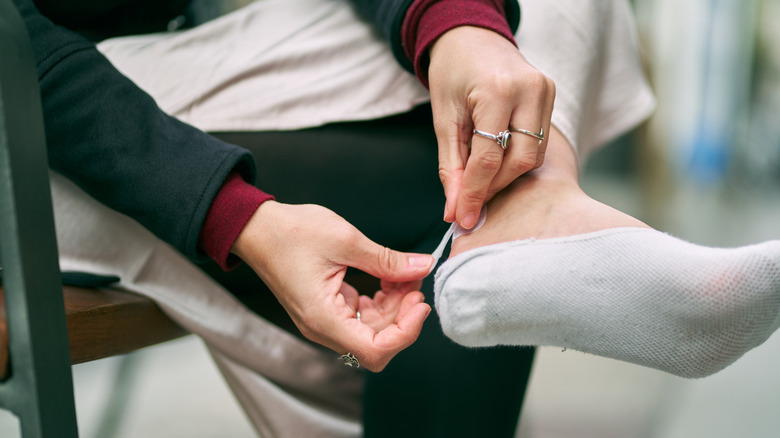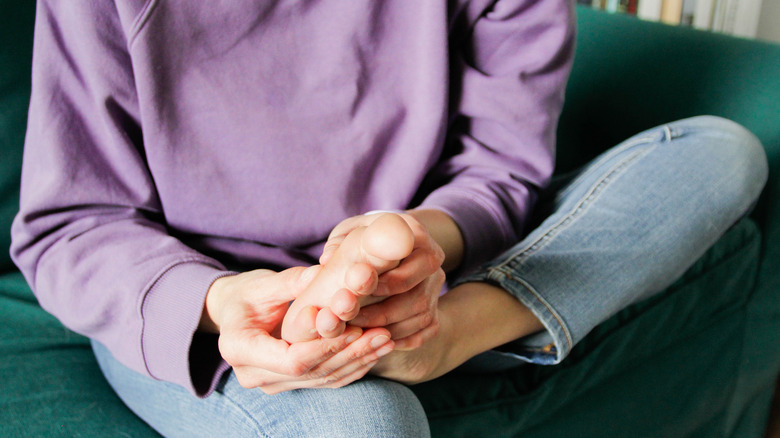A Mountaineering Instructor's Genius Hack Keeps Your Feet Blister-Free On Long Sightseeing Days
Let's be honest: There's no time to waste when you're on vacation. Considering that most trips don't (unfortunately) last forever, traveling often means long days of walking, exploring, and sightseeing as you do your best to tick everything off your list. However, all of that walking and standing around comes with a price: travel-weary feet in need of relief (perhaps using Samantha Brown's doctor-reviewed tips). Whether you aren't used to walking that much at home, make the mistake of wearing shoes that aren't totally broken in, or simply push yourself a little too hard, there's nothing more frustrating and painful to slow you down than a blister.
Thankfully, though, there's an easy way to make sure that you don't end up with sore, blistered feet on holiday. According to Kate Sielmann (better known as @mountaineering_coach_kate to her more than 100,000 followers on Instagram), there's a handy blister-prevention trick she swears by in the mountains. The hack can work just as well (if not better) for all of your city sightseeing adventures.
Sielmann's secret? ENGO Blister Patches. Available in packs of two or more, these small blue patches were originally designed to help reduce skin breakdown for people with prosthetics. That said, Sielmann and other outdoor enthusiasts swear by them, saying they work wonders for preventing the painful blisters that can easily cut a great day of exploration short.
How ENGO patches work and when to use them
ENGO patches feature a slick, slippery surface that directly addresses the main cause of blisters: friction. Unlike bandages, however, you apply these small blue patches directly inside your shoes (not on your feet) at the spots where you typically experience discomfort. That way, when you walk, your sock smoothly slides over the patch instead of rubbing against the shoe.
To use them effectively, the first thing you need to do is identify where you tend to get blisters or hot spots. A few common areas include the back of the heel, the sides of your feet, or the ball of your foot. Then, clean and dry the inside of your shoe at those locations, peel off the patch's backing, and stick it directly onto the shoe lining. The patches should adhere firmly and stay in place for a surprisingly long time.
In fact, according to Sielmann, a single patch can last for hundreds of miles of walking. Once applied, you'll know it's time to replace them when it starts turning white, and the slick blue surface has worn away. Ultimately, this durability makes them perfect for extended vacations or multi-day trips when you need reliable protection day after day.
Discover more tips for blister-free feet on vacation
Along with using ENGO patches, there are several other things you can do to keep your feet nice and comfortable on vacation. For starters, make sure to fully break in any new shoes before your trip. Ensuring that your shoes already feel comfortable before you leave home means they'll be less likely to rub or cause pressure in all the wrong places. Also, consider alternating between two pairs to help keep your feet feeling fresh on long sightseeing days and give each pair time to fully dry out and regain their cushioning. Oh, and it probably goes without saying, but don't make vacation packing mistakes like bringing a brand new pair of shoes on holiday (unless it's absolutely necessary). An unfamiliar pair of shoes can quickly cause problems you might not be able to solve while traveling somewhere new.
Similarly, it's important that you consider your sock choice carefully. Ideally, you'll want to avoid cotton socks which hold moisture and increase friction. Instead, opt for moisture-wicking materials like merino wool or synthetic blends. These materials will help keep your feet dry, significantly reducing your chance of developing painful blisters.
Lastly, stay one step ahead of blisters by addressing any hot spots immediately. If you feel a warm or sensitive area developing on your foot, stop and apply protection right away. Carry around a DIY first aid kit with bandages and antibiotic cream to address any issues before they get worse. Then, at the end of each day, make sure you give your feet enough time to rest, reset, and recover. Elevate them, soak them in Epsom salts, and give them a gentle massage.


